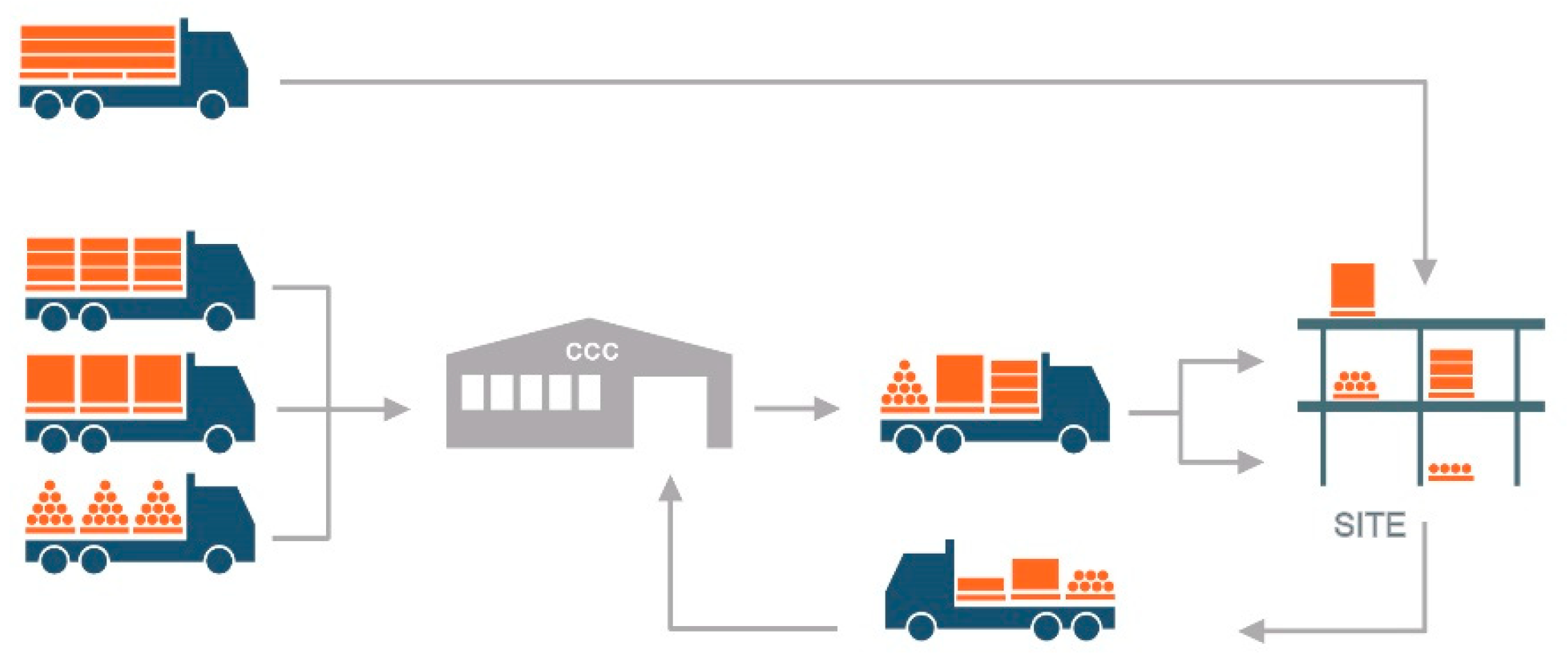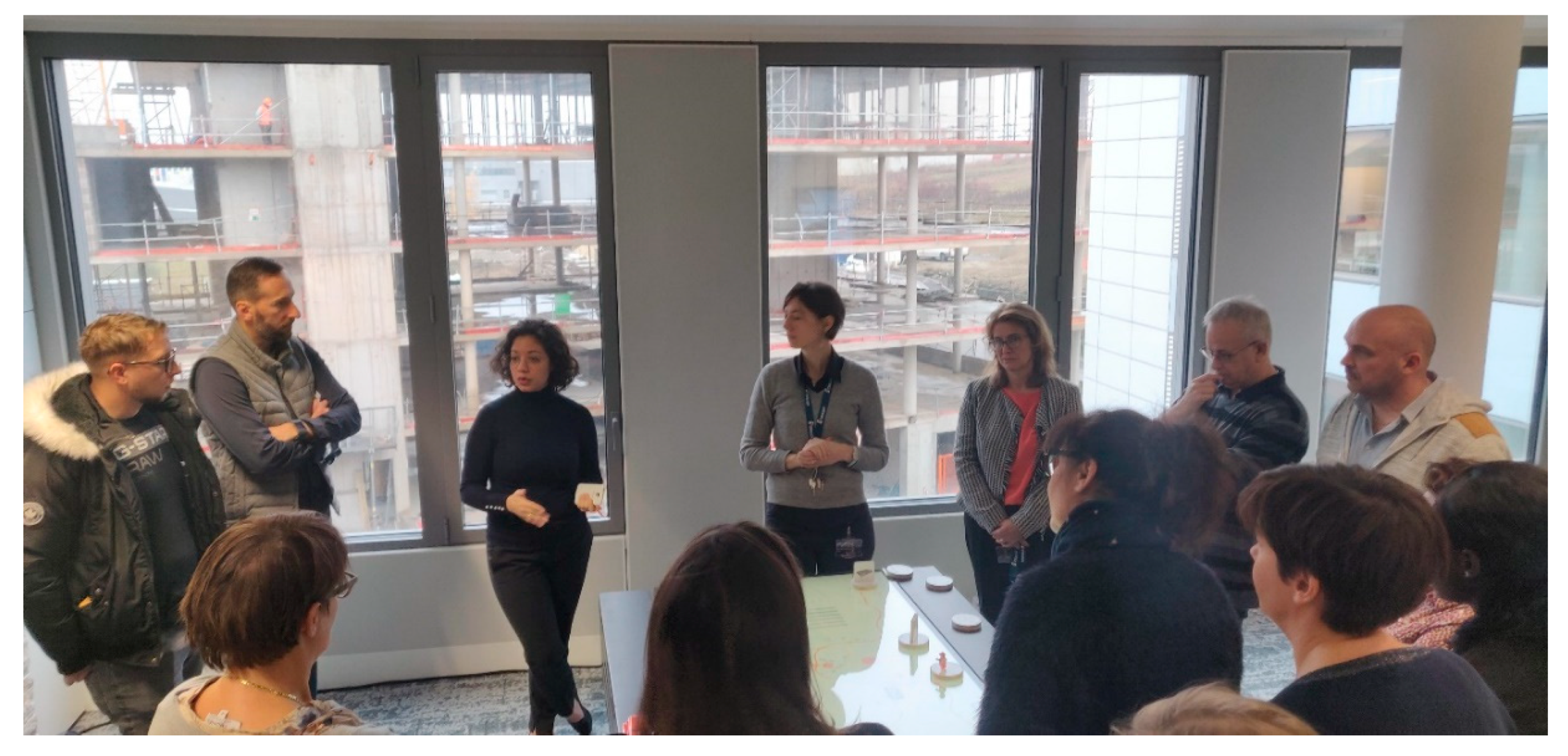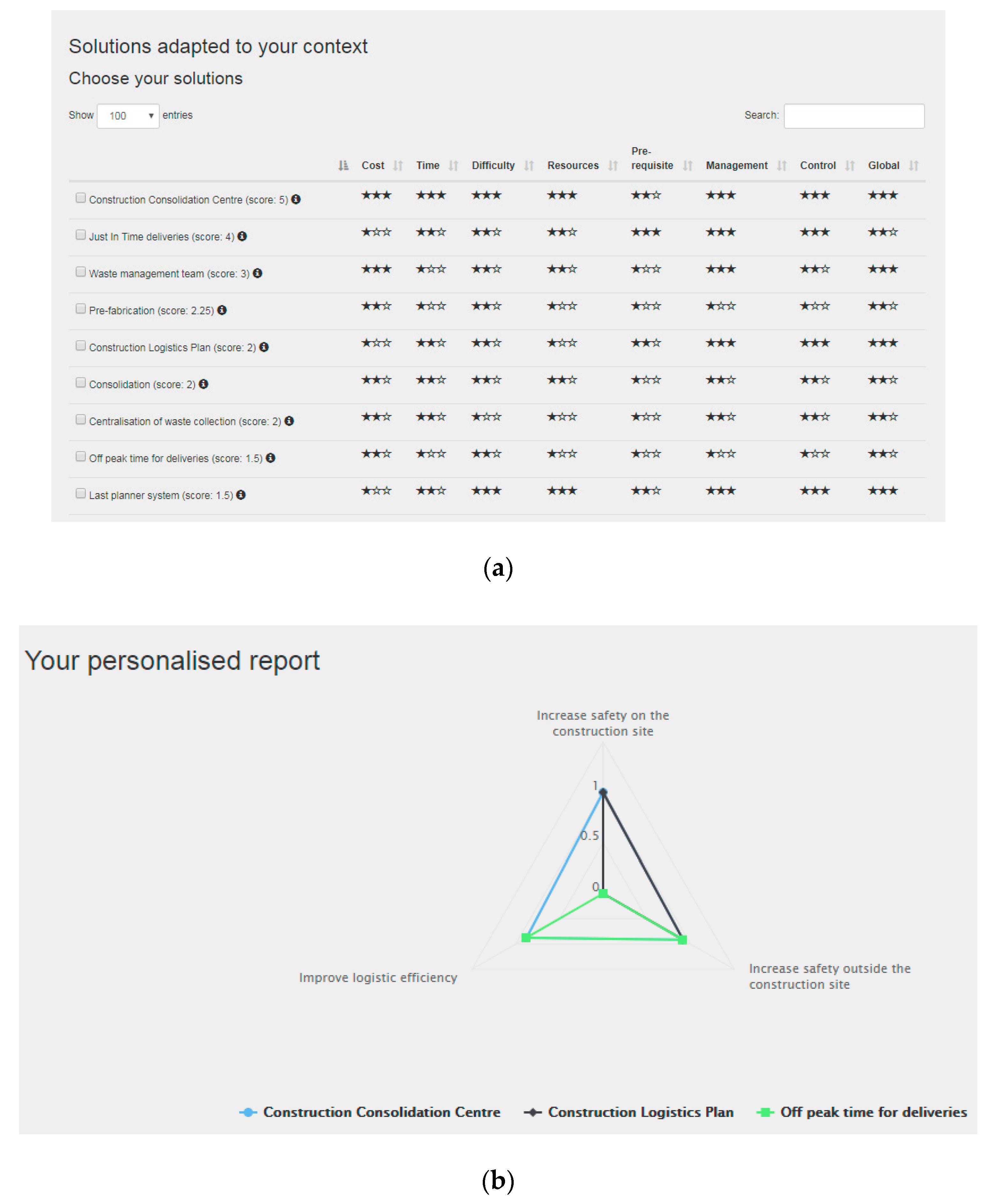Decision Support Systems for Smarter and Sustainable Logistics of Construction Sites
Abstract
:1. Introduction
2. Background
3. The Collaborative Policy Impact Assessment DSS
3.1. Aim
3.2. Methodology
3.3. Data Collection
3.4. Data Representation
3.5. Results
3.5.1. Impact of the size of the vehicle
- The baseline represents the distribution of vehicles observed on the four constructions sites (current situation), with a mix of light (30% of the total), medium (20% of the total), and heavy (50% of the total) vehicles;
- Light (<3.5 t): with this measure, only light (N1 size) vehicles are allowed to deliver goods in the city center;
- Medium (Rigid trucks between 7.5 t and 12 t);
- Heavy (Articulated trucks between 28 t and 34 t).
3.5.2. Impact of the Emission Standard of the Vehicle
- The baseline represents the distribution of vehicles observed on the four constructions sites (current situation), with a mix of Euro II (11.3%), Euro III (5.5%), Euro IV (17.3%), Euro V (36.9%), and Euro VI (29%);
- Euro IV: all vehicles are replaced by Euro IV vehicles of similar size;
- Euro VI: all vehicles are replaced by Euro VI vehicles of similar size.
3.5.3. Impact of the Introduction of a CCC and Its Location
3.5.4. Impact of Combined Policy Measures
- Size of the vehicle for inbound flows: heavy trucks;
- Emission standards: restriction to Euro VI class;
- Use of CCC: located closest to the construction sites.
3.6. Experimentation and Validation
4. The SUCCESSFUL Toolkit
- SUCCESSFUL-Action Plan: the DSS assesses the logistics complexity of a given set of projects in a given city and identifies the most appropriate optimization measures;
- SUCCESSFUL-CCC Locator: the DSS identifies the optimal location of a CCC among a given set of options;
- SUCCESSFUL-CBA4CCC: the DSS assesses the costs and the benefits that a CCC would bring for a given set of projects in a given city.
4.1. SUCCESSFUL-Action Plan DSS
4.1.1. Aim
4.1.2. Methodology
- In the first step, the DSS helps the decision-maker (a construction company or a local authority) to evaluate the logistics profile of a construction site, which reflects its complexity. This step determines which projects should receive highest priority within a portfolio of projects that were already evaluated.
- In the second step, the decision-maker selects among the evaluated projects a construction site to which he or she wants to give more attention (i.e., construction projects classified as high priority) and selects the objectives that his or her organization targets. Finally, the decision-maker is guided in the preparation of an action plan with a selection of the most appropriate measures based on the overall complexity of the project and the selected objectives.
4.1.3. Step 1: Evaluating the Logistics Profile of the Construction Project
4.1.4. Step 2: Exploring Solutions Adapted to Its Profile
4.2. SUCCESSFUL-CBA4CCC DSS
4.2.1. Aim
4.2.2. Methodology
4.2.3. CBA4CCC Construction Company
- Improvement of labor force’s productivity;
- Better use of materials due to fewer stolen/damaged items;
- Better reliability and punctuality of deliveries;
- Increased safety conditions on site due to the reduction of material handling;
- Benefits of the just-in-time method applied to the construction industry;
- Reduced stock on site;
- Reduced number of vehicles on site and better delivery planning;
- Waste reduction and possibility to use round trips for reverse logistics.
- The inflation rate (%);
- The discount rate (%);
- The location of the CCC or the average distance (km) from the CCC to the construction sites;
- If the user provides the location of the CCC, the DSS calculates the average distance via the DSS CCC locator.
- The number of working days (per year);
- The number of construction sites;
- The number of deliveries to each construction site (average number per day);
- The turnover of all the construction projects (€/year);
- The share of the labor force that will benefit from the CCC compared to the total cost of the project (%);
- The share of the material cost that will be delivered by the CCC compared to the total cost of the project (%);
- The rental cost of the CCC (€/m²/month).
- Cost of the facility (€);
- Cost of the staff (€);
- Cost of operating the vehicles (€);
- General expenses of the CCC (€).
- Personnel savings (€);
- Savings due to better utilization of materials (€);
- Savings due to unsorted bins (€).
- Facility (m²): total surface needed included the one for the storage;
- Fleet of vehicles: number of trucks recommended per tonnage;
- Labor force: number of managers, operators, drivers and other staff;
- Equipment: number of different types of handling equipment at the CCC (e.g., forklifts).
4.2.4. CBA4CCC Logistics and Service Provider
- The inflation rate (%);
- The discount rate (%);
- The location of the CCC or the average distance (km) from the CCC to the construction sites;
- The number of working days (per year);
- The number of construction sites served by the CCC;
- The number of deliveries to each construction site (average number per day);
- The turnover of all the construction projects (€/year);
- The price per unit moved (€/pallet).
- Cost of the facility (€);
- Cost of the staff (€);
- Cost of operating the vehicles (€);
- General expenses of the CCC (€).
4.2.5. CBA4CCC Material Supplier
- Better vehicle utilization (better load factor);
- Better driver utilization (reduction in travel time);
- Reduction of the unit cost of transport for the final delivery stage;
- Reduction in the number of vehicle-kilometers;
- Reduction in freight journeys;
- More flexibility for deliveries to the CCC than to the construction site.
- The location of the CCC or the average distance (km) and the average time (min) from the CCC to the construction sites;
- The average distance (km) and the average time (min) from the warehouse to the CCC.
- Time saving for unloading operations (min);
- Saving for not traveling outside the construction site (min, km, and €);
- Saving for not traveling inside the construction site (min, km, and €);
- Cost saving from the congestion charge (€);
- Transport saving per delivery (€/delivery).
4.2.6. CBA4CCC Public Authorities
- Transport optimization for last-mile distribution inside the city;
- Incentives to use environmentally friendly vehicles for the last-mile distribution;
- Reduction in the number of vehicle-kilometers and freight journeys;
- Reduction in congestion inside the city (for direct and reverse logistics);
- Reduction of pollutant emissions inside the city;
- Reduction in the number of construction vehicles entering the city;
- Improvement of the working environment and the living conditions of the citizens;
- Waste reduction;
- Health and safety improvements due to better working conditions.
- The location of the CCC or the average distance (km) and the average time (min) from the CCC to the construction sites;
- The number of construction sites;
- The average daily number to each construction site.
- Distance saved inside the city (km);
- Revenue from the congestion charge (€);
- CO emissions avoided inside the city (kg);
- PM2.5 emissions avoided inside the city (ppm);
- PM10 emissions avoided inside the city (ppm);
- NOx emissions avoided inside the city (kg);
- CO2 emissions not generated inside the city (kg);
- Number of trucks removed from the city (vehicles).
4.3. SUCCESSFUL-CCC Locator DSS
4.3.1. Aim
4.3.2. Proposed Framework
4.4. Experimentation and Validation
- The quantification of indicators in each CCC: it strongly depends on the local context and makes the generalization of the evaluation of the benefits difficult. The complexity of CCC practices makes their assessment with a standard tool quite difficult.
- The opportunity of raising awareness: cities noted that it gives useful estimations to assess the impact of the CCCs’ activation and it can be a starting point for a more detailed cost–benefit analysis. The evaluation should be followed with more detailed and tailored analyses with reference to the specific case before taking decisions to introduce a CCC or not.
- The tool can be useful for a high-level support to decision-making;
- The matching between the measures and the variables;
- The tool does not provide a statistically reliable basis to generalize;
- The tool can help dialogue and communication between public and private stakeholders.
5. General Discussion
6. Conclusions
Author Contributions
Funding
Acknowledgments
Conflicts of Interest
References
- United Nations. 68% of the World Population Projected to Live in Urban Areas by 2050, Says UN; United Nations Department of Economic Social Affairs: New York, NY, USA, 2018. [Google Scholar]
- United Nations. Around 2.5 Billion More People Will Be Living in Cities by 2050, Projects New UN Report; United Nations Department of Economic Social Affairs: New York, NY, USA, 2018. [Google Scholar]
- European Commission. A European Strategy for Low-Emission Mobility. 2016. Available online: https://eur-lex.europa.eu/resource.html?uri=cellar:e44d3c21-531e-11e6-89bd-01aa75ed71a1.0002.02/DOC_1&format=PDF (accessed on 26 April 2019).
- ALICE. Urban Freight Research Roadmap; European Road Transport Research Advisory Council: Brussels, Belgium, 2015. [Google Scholar]
- UN-Habitat; European Union. The State of European Cities 2016: Cities Leading the Way to a Better Future; United Nations Organization: New York, NY, USA, 2016; ISBN 978-92-1-132717-5. [Google Scholar]
- European Commission. Roadmap to a Single European Transport Area—Towards a Competitive and Resource Efficient Transport System; European Commission: Brussels, Belgium, 2011. [Google Scholar]
- Morganti, E.; Seidel, S.; Blanquart, C.; Dablanc, L.; Lenz, B. The Impact of E-commerce on Final Deliveries: Alternative Parcel Delivery Services in France and Germany. Transp. Res. Procedia 2014, 4, 178–190. [Google Scholar] [CrossRef]
- Taniguchi, E.; Thompson, R.G. City Logistics: Mapping the Future; CRC Press: Bocaton, FL, USA, 2014; ISBN 978-1-4822-0889-4. [Google Scholar]
- McKinsey. Parcel Delivery—The Future of Last Mile; McKinsey & Company: New York, NY, USA, 2016. [Google Scholar]
- Amstel, W.P.V.; Wagter, H.; Quak, H.; Boer, E.D. Annual Outlook City Logistics 2050. 2017. Available online: https://www.researchgate.net/profile/Walther_Ploos_van_Amstel/publication/320831599_Annual_Outlook_City_Logistics_2050/links/59fc6894aca272347a211f7b/Annual-Outlook-City-Logistics-2050.pdf (accessed on 26 April 2019).
- Dablanc, L. Freight Transport for Development Toolkit: Urban Freight; The World Bank: Washington, DC, USA, 2009; pp. 1–57. [Google Scholar]
- The Economist. The Construction Industry’s Productivity Problem—Can We Fix It? 2017. Available online: https://www.economist.com/leaders/2017/08/17/the-construction-industrys-productivity-problem (accessed on 26 April 2019).
- Aalto University. iCONS: Boosting Construction Productivity with Indoor Positioning. 2019. Available online: https://www.aalto.fi/en/news/icons-boosting-construction-productivity-with-indoor-positioning (accessed on 26 April 2019).
- Marcucci, E.; Danielis, R. The potential demand for a urban freight consolidation centre. Transportation 2008, 35, 269–284. [Google Scholar] [CrossRef]
- Leonardi, J.; Dablanc, L.; Van Egmond, P.; Guerlain, C. Feasibility Study of a Network of Consolidation Centres in Luxembourg. In Proceedings of the 10th International Conference on City Logistics, Tenerife, Spain, 17–19 June 2015; p. 15. [Google Scholar]
- Allen, J.; Browne, M.; Woodburn, A.; Leonardi, J. The Role of Urban Consolidation Centres in Sustainable Freight Transport. Transp. Rev. 2012, 32, 473–490. [Google Scholar] [CrossRef]
- Janjevic, M.; Kaminsky, P.; Ndiaye, A.B. Downscaling the consolidation of goods—State of the art and transferability of micro-consolidation initiatives. Eur. Transp. 2013, 23. [Google Scholar]
- Le Pira, M.; Marcucci, E.; Gatta, V.; Inturri, G.; Ignaccolo, M.; Pluchino, A. Integrating discrete choice models and agent-based models for ex-ante evaluation of stakeholder policy acceptability in urban freight transport. Res. Transp. Econ. 2017, 64, 13–25. [Google Scholar] [CrossRef]
- Lindholm, M. A sustainable perspective on urban freight transport: Factors affecting local authorities in the planning procedures. Procedia Soc. Behav. Sci. 2010, 2, 6205–6216. [Google Scholar] [CrossRef]
- Van Rooijen, T.; Quak, H. City Logistics in the European CIVITAS Initiative. Procedia Soc. Behav. Sci. 2014, 125, 312–325. [Google Scholar] [CrossRef]
- Witkowski, J.; Kiba-Janiak, M. The Role of Local Governments in the Development of City Logistics. Procedia Soc. Behav. Sci. 2014, 125, 373–385. [Google Scholar] [CrossRef]
- Balram, S.; Dragicevic, S.; Feick, R. Collaborative GIS for spatial decision support and visualization. J. Environ. Manag. 2009, 90, 1963–1965. [Google Scholar] [CrossRef] [PubMed]
- Hall, G.B.; Moore, A.; Knight, P.; Hankey, N. The extraction and utilization of local and scientific geospatial knowledge within the Bluff oyster fishery, New Zealand. J. Environ. Manag. 2009, 90, 2055–2070. [Google Scholar] [CrossRef] [PubMed]
- Salter, J.D.; Campbell, C.; Journeay, M.; Sheppard, S.R.J. The digital workshop: Exploring the use of interactive and immersive visualisation tools in participatory planning. J. Environ. Manag. 2009, 90, 2090–2101. [Google Scholar] [CrossRef] [PubMed]
- Bugs, G.; Granell, C.; Fonts, O.; Huerta, J.; Painho, M. An assessment of Public Participation GIS and Web 2.0 technologies in urban planning practice in Canela, Brazil. Cities 2010, 27, 172–181. [Google Scholar] [CrossRef]
- Davies, S.R.; Selin, C.; Gano, G.; Pereira, Â.G. Citizen engagement and urban change: Three case studies of material deliberation. Cities 2012, 29, 351–357. [Google Scholar] [CrossRef]
- Haklay, M.; Jankowski, P.; Zwoliński, Z. Selected modern methods and tools for public participation in urban planning—A review. Quaest. Geogr. 2018, 37, 127–149. [Google Scholar] [CrossRef]
- Guerlain, C.; Cortina, S.; Renault, S. Towards a collaborative Geographical Information System to support collective decision making for urban logistics initiatives. In Proceedings of the 9th International Conference on City Logistics, Tenerife, Spain, 17–19 June 2015. [Google Scholar]
- Ogden, K.W. Urban Goods Movement: A Guide to Policy and Planning; Ashgate: Aldershot, UK; Brookfield, VT, USA, 1992; ISBN 978-1-85742-029-6. [Google Scholar]
- Russo, F.; Comi, A. A classification of city logistics measures and connected impacts. Procedia Soc. Behav. Sci. 2010, 2, 6355–6365. [Google Scholar] [CrossRef]
- Stathopoulos, A.; Valeri, E.; Marcucci, E. Stakeholder reactions to urban freight policy innovation. J. Transp. Geogr. 2012, 22, 34–45. [Google Scholar] [CrossRef]
- Ebrahimi, H.; Tadic, M. Optimization of dangerous goods transport in urban zone. Decis. Mak. Appl. Manag. Eng. 2018, 1, 131–152. [Google Scholar] [CrossRef]
- McKinsey. Imagining Construction’s Digital Future; McKinsey & Company: New York, NY, USA, 2016. [Google Scholar]








| Token | Description |
|---|---|
| Construction sites | Display the location and size of the construction sites. |
| Suppliers | Allow the selection between 3 different options for the suppliers who deliver freight to the construction sites: their location, the number of deliveries originating from each supplier, and the total tonnage delivered by it. |
| Vehicle emission standard | Allow the selection between 3 different options for vehicle emissions standards: baseline (current situation), Euro IV, Euro VI. |
| Vehicle size | Allow the selection between 4 different options for vehicle emissions standards: baseline (current situation), light (<3.5 t), medium (rigid trucks between 7.5 t and 12 t), heavy (articulated trucks between 28 t and 34 t). |
| CCC | Allow the selection between 3 different potential locations for a CCC: baseline (no CCC), option 1 (Bettembourg), option 2 (Senningenberg), option 3 (Hamm). |
| Dashboard | Display results associated with the selected options for CCC, vehicle size, and vehicle emission standard for a set of 6 indicators: number of deliveries (total), distance traveled (total, km), CO2 emissions (total, g), PM2.5 emissions (total, g), PM10 emissions (total, g), and the disease burden expressed in DALYs (disability-adjusted life years). |
| Zoom in/out | Move the map and zoom in and out. |
| Initial view | Reset the center point of the map and the zoom level. |
| Reset scenario | Reset the vehicle size, emission standard, and CCC to the baseline’s results. |
| Urban Dimension | Site Dimension |
|---|---|
| Site location | Turnover |
| Neighborhood’s environmental sensitivity | Building size |
| Regulation | Storage capacity |
| Maturity level of local authorities | Time pressure |
| Exposure to air pollution and traffic noise | Subcontractors |
| Congestion | Site access |
| Topography | Delivery areas |
| Topology | Handling equipment |
| Construction activity | Certification |
| Logistics strategy | |
| Scope of the project | |
| Construction’s intended usage | |
| Change in project scope |
| Variable | Slightly Complex | Moderately Complex | Very Complex | Extremely Complex |
|---|---|---|---|---|
| Site location | In the suburbs of a small city | In the center of a small city or in the suburbs of a medium city | In the suburbs of a large city or in the center of a medium city | In the center of a large city |
| Regulation | Low | Moderate | High | Very high |
| Turnover | <20 M€ | Between 20 and 50 M€ | Between 50 and 100 M€ | >100 M€ |
| Storage capacity | <0.3 | Between 0.3 and 0.7 and storage not fragmented or located on the same level | Between 0.3 and 0.7 and storage fragmented or located on different levels | >0.7 |
| Variable | Logistics Team |
|---|---|
| Turnover | ≥2 |
| Building size | ≥2 |
| Storage capacity | ≥3 |
| Time pressure | ≥2 |
| Subcontractors | 2; 4 |
| Handling equipment | ≤2 |
| Logistics strategy | ≤2 |
© 2019 by the authors. Licensee MDPI, Basel, Switzerland. This article is an open access article distributed under the terms and conditions of the Creative Commons Attribution (CC BY) license (http://creativecommons.org/licenses/by/4.0/).
Share and Cite
Guerlain, C.; Renault, S.; Ferrero, F.; Faye, S. Decision Support Systems for Smarter and Sustainable Logistics of Construction Sites. Sustainability 2019, 11, 2762. https://doi.org/10.3390/su11102762
Guerlain C, Renault S, Ferrero F, Faye S. Decision Support Systems for Smarter and Sustainable Logistics of Construction Sites. Sustainability. 2019; 11(10):2762. https://doi.org/10.3390/su11102762
Chicago/Turabian StyleGuerlain, Cindy, Samuel Renault, Francesco Ferrero, and Sébastien Faye. 2019. "Decision Support Systems for Smarter and Sustainable Logistics of Construction Sites" Sustainability 11, no. 10: 2762. https://doi.org/10.3390/su11102762






